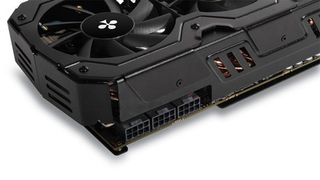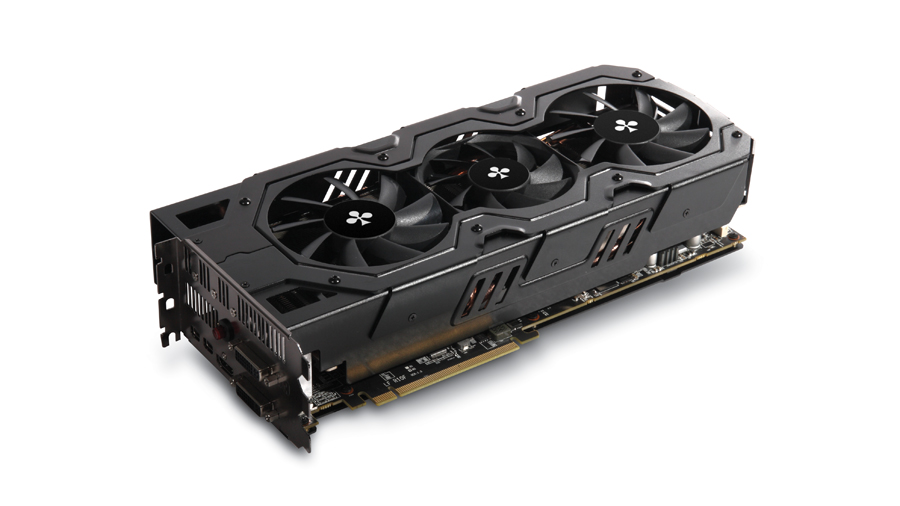TechRadar Verdict
Pros
- +
Reduced power consumption compared to CrossFireX setups
- +
Good performance
- +
Well engineered
Cons
- -
A bit pricey for a normal gaming rig
Why you can trust TechRadar
Sadly, it seems like AMD has abandoned the whole multi-GPU game, giving up the high ground to its Nvidia-shaped competition. Despite previous rumours to the contrary, AMD hasn't managed to furnish us enthusiasts with a GCN powered dual-GPU graphics card.
The HD 6990 then was the last beefy multi-GPU card straight out of the state of Texas. Luckily we don't have to rely on the ten-gallon-hatwearers for all our AMD goodies though, and thanks to the groovy Holland-based techies at Club3D we have in our hands its own version of the very tippy-top of the AMD graphics tree.
AMD hasn't said why it chose not to release the HD 7990 itself, but we would hazard a guess at a combination of expense and, quite frankly, there being little real need for such a niche graphics card in any great numbers. Nvidia released its own dual-GPU card this year, the GTX 690, for over £800, and realistically you could get similar results from a pair of much cheaper GTX 670s.
Coupled with the fact that few people are running huge resolution screens demanding the sort of processing power on offer, that made them less of a vital proposition. AMD has concentrated on getting its HD 7970s and HD 7950s out of the door at ever cheaper price-points, making better use of its Tahiti GPUs and leaving its partners to get on and do a little development work themselves.
But as a thing of technical beauty and engineering excellence, you've got to love the idea of mashing two high-powered GPUs onto a single slab of PCB. As you would expect, the Club3D HD 7990 is a triple slot card housing a pair of AMD's top GPUs - the Tahiti XT. That's the chip you'll find at the heart of the HD 7970 GHz Edition - the fastest single-GPU consumer graphics card in the world.
Unfortunately though, as is the way of these things, it's not the full-speed GPU you can pick up in the GHz Edition of AMD's top card. The twin Tahitis at the heart of the HD 7990 have base clockspeeds of just 900MHz. There is a secondary BIOS, which is activated via a big red button that you'll find hidden between the video outputs on the backplate and that will push things up to 925MHz.
Considering that's the original clockspeed of the HD 7970 when it first tipped up this time last year, Club3D has done an impressive job of getting the card up to speed.
Unfortunately there are seemingly some driver issues, and when I pushed the card up to its overclocked speeds it actually performed just a little slower in benchmarks than at the stock 900MHz. Impressively though, that was pretty much the only spectre of driver problems that raised its hideous head. Other than that, the card was rock solid in terms of gaming.
Technical analysis
We tested all three setups at 2,560 x 1,600 to really push them, and they were all still able to post impressive figures. Arguably nobody needs this sort of performance, but this is a very niche product with a very niche audience, and they will be ably served by either the Club3D or Nvidia option.
The platform power draw of both setups is impressive, as is the straightline performance. But if raw performance is your only concern, and power and volume is secondary, then the CrossFireX HD 7970 GHz Edition pairing is still top dog.
Benchmarks
Peak power draw
Platform power: Watts: Lower is better
CLUB3D HD 7990: 416
HD 7970 GHZ CF: 610
GTX 680 SLI: 430
DirectX 11 tessellation performance
Heaven 3.0: FPS: Higher is better
CLUB3D HD 7990: 65
HD 7970 GHZ CF: 76
GTX 680 SLI: 72
DirectX 11 gaming performance
Batman: AC FPS: Higher is better
CLUB3D HD 7990: 89
HD 7970 GHZ CF: 100
GTX 680 SLI: 113
DiRT Showdown: FPS: Higher is better
CLUB3D HD 7990: 78
HD 7970 GHZ CF: 119
GTX 680 SLI: 72
Max Payne 3: FPS: Higher is better
CLUB3D HD 7990: 50
HD 7970 GHZ CF: 55
GTX 680 SLI: 56
Sleeping Dogs: FPS: Higher is better
CLUB3D HD 7990: 47
HD 7970 GHZ CF: 56
GTX 680 SLI: 39
CrossFizzle
Performance-wise, the Club3D HD 7990 performs pretty much as you would expect. It's not quite as quick as a pair of CrossFireX HD 7970 GHz Editions, but surprisingly it gives an SLI GTX 680 pairing a good scare. The Nvidia setup on the other hand does just about have the edge in raw performance numbers, and is only a little more expensive.
The real kicker for the HD 7990 though are those GHz Edition cards. As the top-performing graphics card of its generation, despite Nvidia's recent driver enhancements, this is an awesome pairing. That's surely a given. The big problem for the HD 7990 is the fact that it all comes together to cost around the same sort of price as a pair of the single cards with noticeably weaker performance in-game.
But raw performance isn't the only way for the Club3D HD 7990 to make a real case for itself. Dual-card setups aren't the easiest thing to manage in terms of thermals, volume or power requirements, and a single card can really help with those issues - even if it's a simply mammoth card.
Easily the most impressive thing about the HD 7990 is the power management of those twin GPUs. Compared with the HD 7970 GHz Edition pairing, we saw a relative drop of around 200W in peak power draw. The HD 7990 was dragging in around 420W in terms of total platform draw, while the twin graphics card CrossFireX setup demanded well over 600W in turn. That's a huge change in power demands, and while it's not necessarily going to help the HD 7990 pay for itself in energy saving, I have to say it's certainly preferable.
Both the HD 7990 and the twin HD 7970s are recommended to be run from at least a 850W power supply, so it's not like they demand different PSUs, but the closer you get to the limit of a supply's capacity, the lower the efficiency rating will be. Running at 620W on a 850W PSU will run it rather ragged compared to the HD 7990's 420W peak power draw.
Hot, hot, hot

And where you have cards drawing a sizeable chunk of platform power, you have GPUs generating a lot of heat. And, presuming you like your house not being on fire, any kind of machine heat needs some heavy-duty cooling.
The twin HD 7970s create one hell of a racket when they are fully spun up, and whereas the HD 7990 is no shrinking violet in terms of its own volume, it's still much quieter than the two cards screaming in unison. That said, the Nvidia GTX 680s in SLI are quieter still with their reference cooling solutions, and only just draw a little more of the old juice than the HD 7990.
So, for a change in this generation, you've got to look at the Nvidia setup as a viable option. Now the prices for the GTX 680 have become more reasonable, an SLI array isn't much beyond what you'd look at for a top-end AMD solution, and will deliver much quieter, cooler and less power hungry gaming.
The situation remains however that not every modern motherboard is SLI ready, while I'd bet that the majority of intelligent and frankly dishy people reading this will have a mobo in their desktop rig that is already more than capable of dealing with a CrossFireX setup, and definitely one that would house a single HD 7990.
The important thing here is that the Club3D HD 7990 does make a valid case for itself. When I first saw that £700 price tag, I have to admit I really wasn't expecting that I'd be saying anything like that. The engineering feat alone deserves plaudits, especially given the relatively low peak power draw figures compared with a pair of 7970s.
Pricing is always going to be an issue of course, but when you're looking at gaming hardware of this stature, it's down to personal preference. And here you're looking at either the HD 7990 or a pair of GTX 680s. The hot, loud and hungry HD 7970 GHz Edition pairing, just isn't really worth considering.

